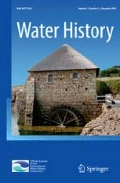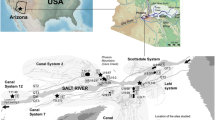Abstract
Crop marks of long canals diverted from ancient rivers were identified on aerial photographs in the valley of Bourgoin-la Verpillière, in the northern part of the Isère department. The environmental multidisciplinary study of the sedimentary fill of these canals sheds light on their function and chronology of use between the Iron Age and the Early Middle Ages (8th century bc–6th century ad). We interpret these hydraulic structures between 0.4 and 2 m deep, as part of large gravity irrigation systems for watering meadows, and even for growing specific crops in the marshes during the Roman period. These findings shed new light on the antiquity of irrigation practices in temperate climate zones and demonstrate the artificialization of wetlands since the Protohistory, based on a sophisticated engineering technology. These new data show that hydraulic systems were integrated into the Iron Age agricultural system several centuries before the Roman Conquest of the Transalpine Gaul in the end of the 2nd century bc.











Similar content being viewed by others
Notes
« The country of the Salassi has gold mines also, which in former times, when the Salassi were powerful, they kept possession of, just as they were also masters of the passes. The Durias River was of the greatest aid to them in their mining—I mean in washing the gold; and therefore, in making the water branch off to numerous places, they used to empty the common bed completely. But although this was helpful to the Salassi in their hunt for the gold, it distressed the people who farmed the plains below them, because their country was deprived of irrigation; for, since its bed was on favourable ground higher up, the river could give the country water. And for this reason both tribes were continually at war with each other.” Translation by H. L. Jones (Loeb Classical Library, 1923).
References
Argant J (2007) L’étude palynologique des niveaux tourbeux et du remplissage du canal gallo-romain (T1) de Frontonas “les Sétives”. Unpublished data
Arnaud P, Hermon E (2008) Conscience de l’impact environnemental et choix d’aménagements concurrentiels des cours d’eau chez les auteurs anciens. In: Hermon E (ed) Vers une gestion intégrée de l’eau dans l’empire romain. l’Erma di Bretschneider, Rome, pp 157–162
Berger J-F (2008) Etude géoarchéologique des réseaux hydrauliques romains de Gaule Narbonnaise (haute et moyenne vallée du Rhône): apports à la gestion des ressources en eau et à l’histoire agraire antique. In: Hermon E (ed) Vers une gestion intégrée de l’eau dans l’Empire Romain. l’Erma di Bretschneider, Rome, pp 107–120
Berger J-F, Jung C (1996) Fonction, évolution et taphonomie des parcellaires en moyenne vallée du Rhône. Un exemple intégré en archéomorphologie et en géoarchéologie. In: Chouquer G (ed) Les formes du paysage: Archéologie des parcellaires. Errance, Orléans, pp 95–112
Bernigaud N (2012) Les anthroposystèmes des marais de Bourgoin-La Verpillière (Isère) du Néolithique final à l’Antiquité tardive (3000 av. J.-C.- 600 ap. J.-C.), Archéologie du paysage et de l’environnement. Unpublished Ph.D. dissertation, Université de Nice Sophia Antipolis, Nice
Bernigaud N, Berger J-F, Bleu S, Bouby L, Delhon C, Franc O, Gaucher G, Latour-Argant C (2011) La bonification antique des grands marais de Bourgoin-La Verpillière (Isère): colonisation, grande hydraulique agricole et mise en culture pendant le Haut-Empire. In: Mathieu N, Rémy B, Leveau P (eds) L’eau dans les Alpes occidentales à l’époque romaine. Cahier du CRHIPA, Grenoble, pp 265–287
Bernigaud N, Berger J-F, Argant J, Bouby L, Bui Thi M, Gaucher G, Lopez-Saez JA, Royet E, Royet R (2013) L’exploitation des prairies marécageuses de la Verpillière et du Grand Plan (Isère), de la Protohistoire au XIXe siècle. In: Galop D (ed) Paysage et Environnement. De la reconstitution du passé aux modèles prospectifs: Environnement, société et archéologie, vol 909. Presses Universitaires de Franche-Comté, Besançon, pp 229–248
Bleu S, Franc O, Bernigaud N, Berger J-F, Latour-Argant C, Girardclos O, Goslar T, Lalaï D, Sarrasin J-C, Saintot S (2007) Bourgoin-Jallieu, “ZAC de la Maladière”, diagnostic archéologique (n° prescription 06-261, code Patriarche 229309). Institut National de Recherches Archéologiques Préventives (INRAP), Bron
Bouby L (2007) L’étude carpologique du remplissage du paléochenal de Frontonas “les Cariaux”. Unpublished data
Bouby L (2010) Agriculture dans le bassin du Rhône du Bronze final à l’Antiquité. Agrobiodiversité, économie, cultures. Thesis, Ecole des Hautes Etudes en Sciences Sociales, Toulouse
Braemer F, Geyer B, Castel C, Abdulkarim M (2010) Conquest of new lands and water systems in the western Fertil Crescent (Central and Southern Syria). Water History 2:91–114. doi:10.1007/s12685-010-0029-9
Bravard J-P (1987) Le Rhône du Léman à Lyon. La Manufacture, Lyon
Briant P (2001) Irrigation et drainage dans l’Antiquité. In: Briant P (ed) Qanats et canalisations souterraines en Iran, en Egypte et en Grèce. Thotm éditions, Paris
Bui Thi Maï (2008) L’étude palynologique du remplissage du fossé du Haut-Empire S15ter à Bourgoin-Jallieu “les Vers”. Unpublished data
Butzer KW, Mateu JF, Butzer EK, Kraus P (1985) Irrigation agrosystems in Eastern Spain: Roman or islamic origins? Ann Assoc Am Geogr 75(4):479–509
Cabouret M (1999) L’irrigation des prés de fauche en Europe occidentale, centrale et septentrionale: Essai de géographie historique. Editions Karthala, Paris
Caucanas S (1995) Moulins et irrigation en Roussillon du IXe au XVe siècle. CNRS Histoire, Paris
Clavel-Lévêque M (1983) Pratiques impérialistes et implantations cadastrales. Ktema 8:185–251
Coutterand S, Schoeneich P, Nicoud G (2009) Le lobe glaciaire lyonnais au maximum würmien, glacier du Rhône ou/et glaciers savoyards? Collection EDYTEM. Cahiers de Géographie 8:9–20
Cremaschi M, Pizzi C, Valsecchi V (2006) Water management and land use in the terramare and a possible climatic co-factor in their abandonment: The case study of the terramara of Poviglio Santa Rosa (northern Italy). Quat Int 151(1):87–98. doi:10.1016/j.quaint.2006.01.020
Darinot F, Morand A (2001) Management of wet meadows in the Lavours marsh, implementing grazing. In: Tools in preserving biodiversity in nemoral and boreonemoral biomes of Europe. Nacomex, pp 86–93
Delhon C, Bernigaud N, Berger J-F, Salvador P-G, Thiébault S (2013) Evolution and management of humid landscape in Northern Dauphiné (Rhone valley, France): contribution of charcoal and wood studies. Holocene. doi:10.1177/0959683613493934
Farrington IS (1980) The archaeology of irrigation canals, with special reference to Peru. World Archaeol 11(3):287–305
Guillon S (2007) L’étude palynologique du remplissage du fossé tardo-antique F05 à Bourgoin-Jallieu “les Vers/ZAC Maladière”. Unpublished data
Hesse R, Baade J (2009) Irrigation agriculture and the sedimentary record in the Palpa Valley, southern Peru. CATENA 77(2):119–129. doi:10.1016/j.catena.2008.09.003
Jaubert de Passa F (1846) Recherches sur les arrosages chez les peuples anciens. Imprimerie et Librairie de Mme Ve Bouchard-Huzard, Paris
Latour-Argant C (2007a) L’étude palynologique du remplissage du canal C8 de Frontonas “les Cariaux”. Unpublished data
Latour-Argant C (2007b) L’étude palynologique du remplissage du bief du moulin S142 à Bourgoin-Jallieu “les Vers/ZAC Maladière”. Unpublished data
Latour-Argant C (2007c) L’étude palynologique du remplissage du canal tardo-antique S391 à Bourgoin-Jallieu “les Vers/ZAC Maladière”. Unpublished data
Leveau P (1998) Échelles d’anthropisation et archéologie des campagnes de Gaule du Sud à l’époque romaine. Méditerranée 4:17–26
Leveau P (2004) Le Rhône et les Romains, “terrassiers infatigables, hydrauliciens habiles”. La géoarchéologie et le renouvellement d’un paradigme. In: Burnouf J, Leveau P (eds) Fleuves et marais, une histoire au croisement de la nature et de la culture. Comité des travaux historiques et scientifiques, Paris, pp 85–91
Leveau P, Saquet J-P (2000) Milieu et sociétés dans la vallée des Baux: Etudes présentées au Colloque de Mouriès, vol 31. Revue Archéologique de Narbonnaise, 11–12 mai 1996
Mandier P, Evin J, Argant J, Petiot R (2003) Chronostratigraphie des accumulations würmiennes dans la moyenne vallée du Rhône: L’apport des dates radiocarbone. Quaternaire 14(2):113–127
Mazoyer M, Roudart L (1997) Histoires des agricultures du monde: Du néolithique à la crise contemporaine. Editions du Seuil, Paris
Piganiol A (1962) Les plans cadastraux de la colonie romaine d’Orange, vol XVIe suppl. Gallia
Purdue L, Miles W, Woodson K, Darling A, Berger J-F (2010) Micromorphological study of irrigation canal sediments: landscape evolution and hydraulic management in the middle Gila River valley (Phoenix Basin, Arizona) during the Hohokam occupation. Quat Int 216(1–2):129–144. doi:10.1016/j.bbr.2011.03.031
Royet R, Berger J-F, Bernigaud N, Royet E (2004) La gestion d’un milieu humide : le site du Vernai et le marais du Grand-Plan à Saint-Romain-de-Jalionas (Isère), de la Tène au haut Moyen Age. In: Burnouf J, Leveau P (eds) Fleuves et marais, une histoire au croisement de la nature et de la culture. Comité des travaux historiques et scientifiques, Paris, pp 253–281
Royet R, Berger J-F, Laroche C, Royet E, Argant J, Bernigaud N, Bouby L, Bui Thi M, Forest V, Lopez-Saez A (2006) Les mutations d’un domaine de La Tène au haut Moyen Age : Le Vernai à Saint-Romain-de-Jalionas (Isère). Gallia 63:283–325
Sigaut F (2003) La faux, un outil emblématique de l’agriculture européenne. In: Comet G (ed) L’outillage agricole médiéval et moderne et son histoire. Presses universitaires du Mirail, Toulouse, pp 281–295
Tatham W (1801) National irrigation, or, the various methods of watering meadows. J and T Carpenter, London
Acknowledgments
The results presented in this paper were obtained in the framework of a Ph.D. in Archeology (Bernigaud 2012), which was supported by the Collective Research Program (PCR) «Peuplement et milieu en Bas-Dauphiné (Isle Crémieu) de l’apparition de l’agriculture à l’époque moderne» founded by the French Ministry of Culture and Communication coordinated by J.-F. Berger (EVS-Lyon 2) and a program of the National Agency for Research (ANR) “Paleohydrology and Human-Climate-Environment Interactions in the Alps “(Pygmalion) coordinated by Fabien Arnaud (Edytem, Chambéry). The research undertaken in Isère was also encouraged by Anne Lebot-Helly, Benoît Helly and Robert Royet from the Service Régional d’Archéologie-Rhône-Alpes and Anne Cayol-Gerin and Annick Clavier from the Conseil Général de l’Isère. We thank the Centre de datation pour le radiocarbone of Lyon 1 University and Laboratoire de Mesure du Carbone 14, UMS 2572, ARTEMIS in Saclay for 14C measurements by SMA in the framework of the National Service to CEA, CNRS, IRD, IRSN and the French Ministry of Culture and Communication. We are grateful to Stéphane Bleu and Odile Franc from the Institut National de Recherches Archéologiques Préventives (INRAP) and to all those who participated to the field operations: Grégory Gaucher, Pierre-Gil Salvador, Louise Purdue, and Sébastien Guillon. Finally we would like to thank Auréade Henry and the reviewers for their careful editing of the manuscript.
Author information
Authors and Affiliations
Corresponding author
Rights and permissions
About this article
Cite this article
Bernigaud, N., Berger, JF., Bouby, L. et al. Ancient canals in the valley of Bourgoin-La Verpillière (France, Isère): morphological and geoarchaeological studies of irrigation systems from the Iron Age to the Early Middle Ages (8th century bc–6th century ad). Water Hist 6, 73–93 (2014). https://doi.org/10.1007/s12685-013-0096-9
Received:
Accepted:
Published:
Issue Date:
DOI: https://doi.org/10.1007/s12685-013-0096-9




